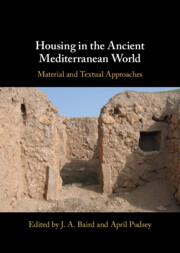Book contents
- Housing in the Ancient Mediterranean World
- Housing in the Ancient Mediterranean World
- Copyright page
- Contents
- Figures
- Tables
- Contributors
- Acknowledgements
- Introduction
- 1 Kinship ‘In the Halls’
- 2 Domesticating the Ancient House
- 3 Mind the Gap
- 4 A Family Affair
- 5 Textiles in Alkestis’ thalamos
- 6 Architectural Rhetoric and the Rhetoric of Architecture
- 7 The Reconstruction of an Agricultural Landscape
- 8 Mudbricks and Papyri from the Desert Sand
- 9 Housing and Community
- 10 The Elusive vestibulum
- 11 Living in the Liminal
- 12 Experiencing Sense, Place and Space in the Roman Villa
- 13 Houses and Time
- 14 Spaces of Desire
- 15 A Response: ‘Using the Material and Written Sources’ Revisited
- Index
- References
9 - Housing and Community
Structures in Houses and Kinship in Roman Tebtynis
Published online by Cambridge University Press: 08 July 2022
- Housing in the Ancient Mediterranean World
- Housing in the Ancient Mediterranean World
- Copyright page
- Contents
- Figures
- Tables
- Contributors
- Acknowledgements
- Introduction
- 1 Kinship ‘In the Halls’
- 2 Domesticating the Ancient House
- 3 Mind the Gap
- 4 A Family Affair
- 5 Textiles in Alkestis’ thalamos
- 6 Architectural Rhetoric and the Rhetoric of Architecture
- 7 The Reconstruction of an Agricultural Landscape
- 8 Mudbricks and Papyri from the Desert Sand
- 9 Housing and Community
- 10 The Elusive vestibulum
- 11 Living in the Liminal
- 12 Experiencing Sense, Place and Space in the Roman Villa
- 13 Houses and Time
- 14 Spaces of Desire
- 15 A Response: ‘Using the Material and Written Sources’ Revisited
- Index
- References
Summary
This chapter brings together Greek documentary papyri from family archives in and around the town of Tebtynis in the Fayyum, with the archaeological record for housing across the region. In so doing, it presents a case for understanding the ownership, transactions and leasing of houses, or parts of houses, as a means to develop or preserve social status and standing in these towns and villages. The chapter explores transactions in the papyri between known individuals, against the context of the observed physical life cycle of houses and their associated outside space. It concludes that, for those individuals of specific social status (primarily gymnasial), both close and extended kinship ties were an important part of the considerations when financial transactions took place involving housing. Such activities were crucial to the operation of social positioning within the middle and upper echelons of these relatively small communities in the Fayyum. The extent to which these patterns may be said to be typical of similar elements of kinship and social structures across Roman Egypt is debatable, but the approach taken by this chapter provides a means of exploring these relationships further.
- Type
- Chapter
- Information
- Housing in the Ancient Mediterranean WorldMaterial and Textual Approaches, pp. 300 - 321Publisher: Cambridge University PressPrint publication year: 2022



